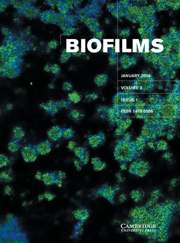Bacteria harnessing complexity
Published online by Cambridge University Press: 07 March 2005
Abstract
The study of bacterial colonies is a crucial step towards understanding biofilms. We review some of the exciting discoveries about bacterial self-organization that might shed new light on biocomplexity in general and biofilms in particular. This review is aimed at researchers from different disciplines – microbiology, biology, chemistry, physics, mathematics and computer science. To make the presentation comprehensible we have avoided the use of specialized terminology of the different disciplines and limited the experimental and computational details.
Bacteria can self-organize into hierarchically structured colonies of 109 to 1012 bacteria, each utilizing a great variety of biochemical communication agents, such as simple molecules, polymers, peptides, complex proteins, genetic material and also “cassettes of genetic information” such as plasmids and viruses. Bacteria use their intracellular flexibility, involving signal transduction networks and genomic plasticity, to collectively maintain self and shared interpretations of chemical cues, exchange of meaning-bearing chemical messages, and dialogues. The meaning-based communication permits the formation of colonial intentional behavior, purposeful alteration of colony structure and decision-making – features we might begin to associate with bacterial social intelligence. Such social intelligence, should it exist, would require going beyond communication to encompass additional intracellular processes, as yet unknown, for generating inheritable colonial memory and commonly shared genomic context.
- Type
- Review Article
- Information
- Copyright
- © 2005 Cambridge University Press
- 37
- Cited by


